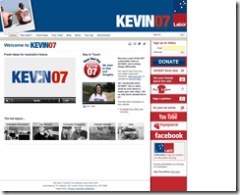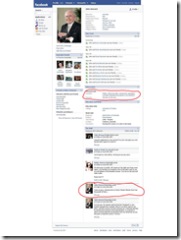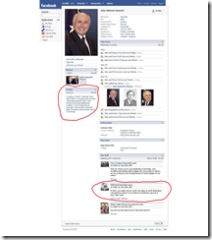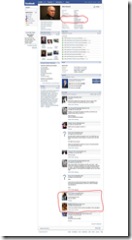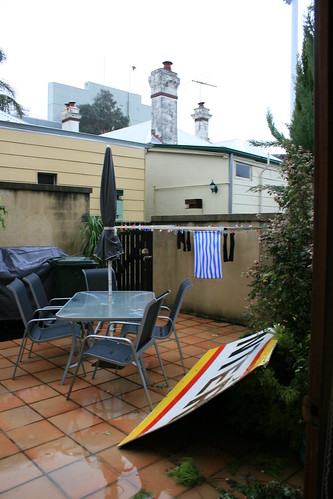Home » advertising (Page 9)
Category Archives: advertising
Dove’s Onslaught
Last year as part of Dove’s ‘Real Beauty’ campaign they produced the important and memorable Evolution video which graphically illustrated the many, many steps between a photograph being taken and the image based on that photograph ending up on a billboard or fashion magazine cover. This year Dove have, in my opinion, produced another fine clip which looks at the tirade of body images and messages young girls and women encounter through various media in their everyday life. It’s called Onslaught:
Incidentally, while I know these viral videos are something of a marketer’s dream, I don’t think that distracts from the message one little bit.
Kevin 07! (Or: Team Rudd gets its Web2.0 on!)

So, Kevin07 is here! Australian Labor leader Kevin Rudd has gotten all web2.0 and has a new portal website which integrates nicely with Labor and Rudd’s re-vamped MySpace page, YouTube and Facebook. As I’ve discussed in the past month, Labor has already shown far more success in using MySpace and Facebook than the Liberal party. Liberal leader and current PM John Howard has tried to use YouTube, but each video clip led to the deleting of comments and each video also seems to have less and less viewers.
Kevin07 was launched today, so for historical archival purposes, here is a full screenshot from day one:
The layout is fairly straight-forward and is clearly based on a the design of both the Hillary08 (screenshot) and Obama08 (screenshot) campaigns for the 2008 US Presidential election. There is a little danger in Australia in pushing the individual (Kevin) over the party (Labor) since Australians are still less comfortable with celebrity politics (hence, among other things, no Australia President) but I’ve got to say I think the Labor media advisors have done a very decent job on this portal. In an article in PerthNow, Rudd’s team certainly seem to be making the right noises about how social software would work during the election campaign:
“Kevin07 will encourage supporters to interact with one another, participate in blogs and stay in touch with what is happening on the campaign trail,” Labor’s campaign director Tim Gartrell said.
On the negative side, ABC News has a story about some very strongly worded responses from Liberal Party faithful:
But Assistant Treasurer Peter Dutton says voters will eventually see the light, and has labelled Mr Rudd’s approach as a “load of crap”.
“People at the moment are looking at Kevin Rudd like they’re looking at a promo for Big Brother,” he said.
“I mean it’s exciting, it’s fresh and when the big night comes, and people actually have a closer look and they look at the detail and they get a better understanding about what the show is about, they actually realise that the show is a load of crap.”
“The thing I say to Australians is please, don’t just look at the media tart, look at the policy detail.”
However, what Peter Dutton fails to understand, is that a generation who started watching Big Brother when they were 13 are old enough to vote this year. More to the point, dismissing the web, which is a central social space for those in the late teens and twenties, is clearly alienating the majority of a key demographic group. On more stable ground, The Age has tried to take Team Rudd to task for not registering all the possible Kevin07 variant domains (.net, .org etc) but if that’s the only issues the mainstream media can find, then I’d have to say Kevin07 is a winner in terms of design and its connectivity with voters.
The US Presidential Race ’08 is now a pillow-fight between bikini-clad crush girls!
As Chuck and a quite a few others have pointed out, Barely Political have released another viral video, this time featuring an MTV style showdown between the singing, dancing political spokesmodel* Obama Girl and her political nemesis, Giuliani Girl:
I rather like Chuck’s description of this clip as a “a singing and dancing competition on the streets of Brooklyn that suggests a spiced up version of West Side Story, with a little politics thrown in.” As with the Obama Girl and Hott4Hill clips discussed earlier, the question as to whether these clips actually have any meaningful place in promoting political awareness is an important one. The lyrics certainly presume some knowledge of politics and of the candidates, but I suspect the demographic most likely to be watching the videos in YouTube are probably not of voting age.
As Craig Rubens from NewTeeVee asks:
Is this the “Happy Birthday Mr. President” of the YouTube era? The ladies of Barely Political owe quite a bit to the imitable Marilyn Monroe. Or is this more the Jib Jab of the 2008 election, whose This Land traveled in very much the same media circles back on ‘04?
I like the comparison with Jib Jab, as it certainly reminds us that US politics has already had its first election (’04) with viral video input, and the Crush Girl vids have some sort of history. That said, I also worry with Rubens that for all the cynicism about politics in the US, given such a narrow ranges of choices at the end of the day, these clips really could make a difference in an apathetic voter’s mind:
So, will Barely Political work its way up to political punditry levels of Stewart/Colbert? Likely not, but it’s broken new ground with the powers of viral videos, coming out with multiple iterations of a successful formula. I’d like to think that my vote won’t be influenced by Hooters girls chanting political candidates names, but like I said before, I am a member of an easily swayed demographic. So, while maybe not the most cerebral of political commentaries, Obama girl very well might be the most primal.
In a clearer light, it’s great to see Taryn Southern (who didn’t just perform, but also wrote the Hott4Hill clip) bemused by the fact that many commentators are missing the that fact that her clip, at least, is definitely satirical:
I’m still surprised at the number of people who don’t realize the video is a parody. Between Hillary’s face in Mt. Rushmore and my bikini body superimposed on George Washington crossing the Delaware, how could it get anymore silly?
Meanwhile, on the home front, the Oz in 30 Seconds citizen-produced political video campaign in Australia (run by GetUp) has entered the voting phase. Nothing as racy as the US clips, but some really impressive political commentary to be seen here!
* I’ve loved the term spokesmodel ever since hearing it for the first time in the wonderful film LA Story. I’m so pleased to finally have an appropriate context in which to use it!
Facebook and Australian Politics?
Over the past month I’ve suddenly seen Facebook grow from an oddity to something on which the majority of my university-based friends appear. Since I spent some of yesterday pondering the oddities of US politics and digital culture, I thought I’d spend a little of today looking at Australian politics. For those of you not in the know, Australia has what amounts to a two-party political system, divided between Liberal (close to Republican/Tory parties) and Labor (close to the Democrat/UK Labor parties); the Liberal party is led by John Howard, who is our current Prime Minister, while the Labor party, after many years of leadership ambiguity, is led by Kevin Rudd.
Unlike the US (and a lesser extent the UK), mainstream press and politics in Australia really hasn’t embraced either the blogosphere or social networking as a means of promotion or gaining support (and Australian politicians can’t and don’t fund-raise in the explicit way US politicians do). That said, younger voters are clearly looking for some sort of connection with the political sphere, even if its not done through the same rhetoric of civil participation that comes through the US education and advocacy systems. So, that said, is either Australia’s Prime Minster or his Labor rival on Facebook? The answer, initially, appears yes to both, although after some scrutiny, the answer changes to yes for Rudd and no for John Howard – there are, in fact, three Howards, but all are fake.
Of the three Howards, two are obvious fakes, while one is more subtle, but still not authentic. Since this is a fun moment to think about digital literacy, I’ve taken screenshots of the three Howard profiles and circled in red the most obvious indicators that these aren’t authentic pages.
and John Howard #3 …
In contrast, Kevin Rudd’s Facebook page is rather dull, but clearly authentic. (I’ve just made a friend request, so if there’s anything exciting in friends-only land, I’ll write a little more.) It is worth noting that comments which cast John Howard as a sexual or ‘hot’ figure are unambiguously meant to be satirical, in contrast to the clips from the US mentioned yesterday which, while playful, aren’t necessarily ironic (although they might be, especially Hott4Hill).
Putting the Sex (back) into American Politics?
The process by which different US Democrats and Republicans vie for the right to be their party’s candidate for presidency has always fascinated me (admittedly, from afar, safe in the knowledge I don’t need to vote for any of these people). The race for 2004 bought out some impressive efforts in participatory culture (remember Jib Jab’s ‘This Land’?), and this years’ Hillary 1984 video promised more in the race for 2008. While the creativity is definitely out there, one trend which has been a little unexpected is the “I’ve got a crush on…” videos attached to the Democrat candidates.
First there was the self-styled ‘Obama Girl’ with her “I’ve Got a Crush on Obama” video:
The clip and the Obama Girl herself have gained a fair amount of attention in US media, most of which is linked to from Obama Girl’s website. The girl in the clip – Amber Lee Ettinger – didn’t create the concept (or sing the song; she’s lip-synching) but has become one of the key faces in Obama’s campaign. The story behind Obama Girl is found at the Barely Political website. Now, along similar lines but a little more disturbingly, Chuck Tryon has drawn my attention to the “Hott4Hill featuring Taryn Southern” clip, which runs a fine line between representing Hillary Clinton as a politician or a sexual icon(!):
And, of course, there’s a Hott4Hill blog to emphasise Taryn Southern’s efforts.While I’m still thinking about how all of this works (and wonder if these clips have the potential to damage campaigns as much as make them appealing for younger proto-voters) you might want to have a read of ‘The Power and Playfulness of Parody: Obama, Hip Hop and Misunderstanding’ by Bernie Heidkamp in Pop Politics which gives some context and perspective to the Obama Girl clip.
When Subiaco Oval Attacks!
The second half of 2007 hit with something of a bang today. The combination of extreme winds and the proximity of our place to Subiaco Oval suddenly led to the rather loud, dramatic and quite dangerous appearance of the massive advertising signs from Subi Oval hitting out (glass) back door and coming to rest in our back yard:
While fascinating on some level, these huge signs had to travel over the top of the oval (they’re supposedly fixed to the stands) and fly probably 50 metres in the air before spinning down into our place. It’s incredibly lucky that it was pouring with rain, too, because it anyone was outside, being hit by one of these could have caused some very serious injuries.
When the winds settled a little, Emily headed out the front door and discovered a whole lot more of these hoardings lying on our road and in the drive-way, so now we have four massive advertising banners on centimetre-think cardboard sitting soggily in our little backyard:
We now have part of an SGIO sign, a National Australian bank advertisement and something that has NTER in its lettering. I wonder when Subiaco Oval will be knocking on our door looking for them? Maybe they’ll offer to replant the bits of the garden that were sheered in half when the sign flew in from the sky?!
(Given that these signs cost advertisers anywhere from $5000 to $60,000 dollars each to display, I suspect someone might want them back!)
The 4400 Goes Viral (Marketing)
The 4400 has taken to viral marketing dramatically in order to build the word before the upcoming fourth season of the TV show. According to AdWeek:
To promote the new season of The 4400 on USA Network, Campfire has created a wide-ranging interactive world consisting of 80 videos that run from 30 seconds to five minutes and six Web sites. […] The 4400 follows 4,400 people who are abducted, taken away and then returned to planet Earth. After their return, many of them discover they have superpowers. As the fourth season begins on June 17, the plot follows the development of a drug called Promicin: it gives the users superpowers, if it doesn’t kill them. Three different factions emerge around the drug: pro, anti- and neutral.
On YouTube, for example, one of the show’s stars, Billy Campbell, appears in character as Jordan Collier, advocating Promicin and the decrying the government’s attempts to ban the drug. Here’s Jordan Collier dispatch #3:
Elsewhere on the net, we can find the Promicin Power website, which argues that Promicin is the key to world peace and a sustainable relationship with nature. Here’s one example that looks like it could be have been a United Colours of Bennetton advertisement in a past life:
At the other extreme, there’s also Promicin Terror which sees the drug as the biggest threat to the US since Al Qaeda. Clearly building on the famous ‘Daisy‘ political ad of the 60s (which was recycled in the US debates about the War with Iraq), this is an example of a clip campaigning to ban the drug:
I quite enjoyed the last season of The 4400 and am heartened to see the show’s producers so actively embracing the potential of video-sharing and online word-of-mouth. The clips are a little over-produced, but given the state of a lot of TV advertising today, I’m sure they could easily be mistaken for the ‘real thing’.
Hillary 1984
The races for party nomination and the Presidential election in the US always tend to bring out the most creative political media and mashups. The first great political video of the 2008 race is definitely Hillary 1984, which mashes up one of Apple’s most famous advertisements from 1984, using the imagery of 1984, with Hillary Clinton’s campaign launch speach. (Actually, the Apple ad used is the updated version released in 2004, with the sledgehammer-weilding Anya Major given an iPod to wear as she attacks the projections of an Orwellian big brother.)
An article called ‘Political video smackdown’ in San Francisco Chronicle has these sparse details:
It may be the most stunning and creative attack ad yet for a 2008 presidential candidate — one experts say could represent a watershed moment in 21st century media and political advertising. Yet the groundbreaking 74-second pitch for Democratic Illinois Sen. Barack Obama, which remixes the classic “1984” ad that introduced Apple computers to the world, is not on cable or network TV, but on the Internet. […]
The compelling “Hillary 1984” video recently introduced on YouTube represents “a new era, a new wave of politics … because it’s not about Obama,” said Peter Leyden, director of the New Politics Institute, a San Francisco-based think tank on politics and new media. “It’s about the end of the broadcast era.” […]
That theme — reflecting a generational change in the relationship between media, politics, candidates and voters — suggests that “Hillary 1984” could have the iconic power with the 21st century political generation that another classic political ad called “Daisy” represented to Baby Boomers, says Leyden. That 1964 spot for President Lyndon Johnson — featuring images of a child plucking a daisy, which morphed ominously into a nuclear mushroom cloud — battered GOP presidential candidate Sen. Barry Goldwater because it, too, portrayed “a shattering of the whole world” in both political leadership, and media.
Bill Burton, a spokesman for Obama, said he is aware of the “Hillary 1984” video and has gotten calls from reporters on it — but he insisted that the campaign is not connected to it. “It’s somebody else’s creation,” he said, declining to comment on the ad’s biting content. […]
The ad is proof that “anybody can do powerful emotional ads … and the campaigns are no longer in control,” Rosenberg said. “It will no longer be a top-down candidate message; that’s a 20th century broadcast model.”
Citizen media and participatory culture, indeed! 🙂 And the video itself:
Update: For more on the politics on this mashup, see Chuck Tryon’s column ““Why 2008 Won’t Be Like 1984:” Viral Videos and Presidential Politics” in Flow. Also of interest is a statement in the Huffington Post by the video’s creator Phil de Vellis: I Made the “Vote Different” Ad.
300: An Online Marketing Hit
There’s been a lot of talk about 300, which is now, financially at least, the first big blockbuster of 2007. Leaving aside Iran’s outrage at the film’s depiction of their history, one of the most interesting elements of the film was the clever and canny marketing strategies which found success in online arenas where many others have tried, but failed. Deborah Netburn’s article in the LA Times points out that 300 succeeded where others (most notably Snakes on a Plane) only appeared to work until the people voted with their feet at the box office:
Fanboy buzz is not enough to sell a film — “Snakes on a Plane,” anyone? — but Garabedian points out that while the online community was obsessively talking about “Snakes” they were ultimately making fun of it. The people who were driving the chatter around “300” were genuinely excited about the film, especially the way it looked. And after Comic-Con, Warner Bros. marketing department made sure that the fanboys got the usual dribs and drabs of movie art and trailers just to keep their excitement up.
The marketing folks also took full advantage of MySpace. There was of course the requisite MySpace page for the film (now standard for all movies) — featuring a ferocious looking muscle man in a metal helmet plus tons of video clips, wallpapers and links to the film’s official website. But the stroke of genius came when the studio sponsored a feature upgrade to the site that told users they could store 300 photos on their profile thanks to the movie “300.” (Previously the limit had been 12). That started Jan. 2 and was incredibly popular with teens. The result was billions of ad impressions and 8 million viewings of the trailer. Is it any wonder that the 52% of the people who saw “300” were under 25?
There are also mundane reasons “300” might have done well. A generally warm weekend across the country encouraged people to get out of the house and brave long lines, and no other major film was released against “300,” so it didn’t have much competition. And while the critics have been lukewarm on the film — faulting it for poor dialogue and a thin story — nobody has said anything negative about the visuals. And to a generation of kids who have grown up with the lush worlds of video games, “300” was a familiar visual masterpiece.
The ‘300 images’ idea is definitely a clever one, and shows that marketing online really has to think outside the box of traditional hype-building.
On a differrent note, 300 is also interesting in that it was entirely edited on Apple Macs. For the tech details, visit the Raw Feed.

